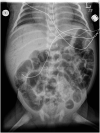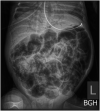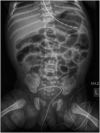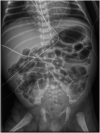Necrotizing Enterocolitis in Neonates With Hyperinsulinemic Hypoglycemia Treated With Diazoxide
- PMID: 33483452
- PMCID: PMC7849198
- DOI: 10.1542/peds.2019-3202
Necrotizing Enterocolitis in Neonates With Hyperinsulinemic Hypoglycemia Treated With Diazoxide
Abstract
The most common cause of persistent hypoglycemia in the neonatal period is hyperinsulinism. Severe, refractory hypoglycemia resulting from hyperinsulinism can lead to significant brain injury and permanent cognitive disability. Diazoxide is the first-line and only US Food and Drug Administration-approved, pharmacologic treatment for refractory hyperinsulinism. In recent years, the use of diazoxide in neonates with persistent hyperinsulinemic hypoglycemia has increased in the United States. Known adverse effects of diazoxide include fluid retention, hypertrichosis, neutropenia, thrombocytopenia, and more recently, pulmonary hypertension. It is currently unknown if diazoxide exposure is associated with an increased risk of necrotizing enterocolitis (NEC) in neonates. We reviewed the cases of 24 patients in a level IV NICU at Massachusetts General Hospital who received diazoxide over 12 years (April 2006-April 2018). All 24 patients received enteral diazoxide for refractory hyperinsulinemic hypoglycemia. A total of 5 patients developed NEC after initiation of diazoxide based on clinical and radiographic findings, corresponding to 20% of infants exposed to diazoxide. This is above our baseline incidence of NEC (1% for all inborn infants and 6% for all inborn very low birth weight infants). More research and monitoring are necessary to characterize the potential risk of NEC associated with the use of diazoxide in the neonatal period.
Copyright © 2021 by the American Academy of Pediatrics.
Conflict of interest statement
POTENTIAL CONFLICT OF INTEREST: The authors have indicated they have no potential conflicts of interest to disclose.
Figures





Similar articles
-
Necrotising enterocolitis in newborns receiving diazoxide.Arch Dis Child Fetal Neonatal Ed. 2021 May;106(3):306-310. doi: 10.1136/archdischild-2020-319057. Epub 2020 Nov 10. Arch Dis Child Fetal Neonatal Ed. 2021. PMID: 33172872
-
Pulmonary Hypertension and Necrotizing Enterocolitis in Neonates Treated with Diazoxide.Am J Perinatol. 2024 May;41(S 01):e1435-e1444. doi: 10.1055/s-0043-1764385. Epub 2023 Mar 7. Am J Perinatol. 2024. PMID: 36882098
-
Prevalence of Adverse Events in Children With Congenital Hyperinsulinism Treated With Diazoxide.J Clin Endocrinol Metab. 2018 Dec 1;103(12):4365-4372. doi: 10.1210/jc.2018-01613. J Clin Endocrinol Metab. 2018. PMID: 30247666 Free PMC article.
-
Development of Pulmonary Hypertension During Treatment with Diazoxide: A Case Series and Literature Review.Pediatr Cardiol. 2017 Aug;38(6):1247-1250. doi: 10.1007/s00246-017-1652-3. Epub 2017 Jun 22. Pediatr Cardiol. 2017. PMID: 28642988 Review.
-
Efficacy and safety of diazoxide for treating hyperinsulinemic hypoglycemia: A systematic review and meta-analysis.PLoS One. 2021 Feb 11;16(2):e0246463. doi: 10.1371/journal.pone.0246463. eCollection 2021. PLoS One. 2021. PMID: 33571197 Free PMC article.
Cited by
-
Standardised practices in the networked management of congenital hyperinsulinism: a UK national collaborative consensus.Front Endocrinol (Lausanne). 2023 Oct 30;14:1231043. doi: 10.3389/fendo.2023.1231043. eCollection 2023. Front Endocrinol (Lausanne). 2023. PMID: 38027197 Free PMC article. Review.
-
Neonatal hyperinsulinism: a retrospective study of presentation and management in a tertiary neonatal intensive care unit in the UK.Arch Dis Child Fetal Neonatal Ed. 2025 Apr 17;110(3):261-268. doi: 10.1136/archdischild-2024-327322. Arch Dis Child Fetal Neonatal Ed. 2025. PMID: 39304222 Free PMC article.
-
Asymptomatic Hyperinsulinemic Hypoglycemia and Grade 4 Intraventricular Hemorrhage in a Late Preterm Infant.J Investig Med High Impact Case Rep. 2021 Jan-Dec;9:23247096211051918. doi: 10.1177/23247096211051918. J Investig Med High Impact Case Rep. 2021. PMID: 34654342 Free PMC article.
-
Diazoxide for Neonatal Hyperinsulinemic Hypoglycemia and Pulmonary Hypertension.Children (Basel). 2022 Dec 21;10(1):5. doi: 10.3390/children10010005. Children (Basel). 2022. PMID: 36670556 Free PMC article. Review.
-
Watchful waiting versus pharmacological management of small-for-gestational-age infants with hyperinsulinemic hypoglycemia.Front Endocrinol (Lausanne). 2023 Jun 14;14:1163591. doi: 10.3389/fendo.2023.1163591. eCollection 2023. Front Endocrinol (Lausanne). 2023. PMID: 37435482 Free PMC article.
References
Publication types
MeSH terms
Substances
Grants and funding
LinkOut - more resources
Full Text Sources
Other Literature Sources
Miscellaneous

